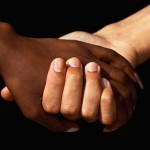By Kari Lerum & Shari Dworkin
For the last several years in the U.S., political discourse around marriage has been dominated by the issue of same-sex couples (both the push to allow same sex couples into the institution of marriage, and the conservative religious push to keep them out). Two days ago the “gay marriage” issue was briefly upstaged in the news with a much older (now considered embarrassing) version of the not so distant U.S. marriage politics: “mixed race” marriages.
 In 1967 the U.S. Supreme Court declared that laws against “miscegenation” (referring to a mixture of “racial” genes, assumed in that context to have negative reproductive effects) were unconstitutional. The overturning of all anti-miscegenation laws was part of a much larger cultural/social/civil rights shift toward more tolerance for (and even support of!) equality between whites and non-whites. Of course, this didn’t and doesn’t eliminate racial discrimination, but the Supreme Court ruling was key in writing anti-racial discrimination around love and marriage into law. Thus, the news that surfaced on Thursday was received by many as a shock:
In 1967 the U.S. Supreme Court declared that laws against “miscegenation” (referring to a mixture of “racial” genes, assumed in that context to have negative reproductive effects) were unconstitutional. The overturning of all anti-miscegenation laws was part of a much larger cultural/social/civil rights shift toward more tolerance for (and even support of!) equality between whites and non-whites. Of course, this didn’t and doesn’t eliminate racial discrimination, but the Supreme Court ruling was key in writing anti-racial discrimination around love and marriage into law. Thus, the news that surfaced on Thursday was received by many as a shock:
NEW ORLEANS – A Louisiana justice of the peace said he refused to issue a marriage license to an interracial couple out of concern for any children the couple might have. Keith Bardwell, justice of the peace in Tangipahoa Parish, says it is his experience that most interracial marriages do not last long.
“I’m not a racist. I just don’t believe in mixing the races that way,” Bardwell told the Associated Press on Thursday. “I have piles and piles of black friends. They come to my home, I marry them, they use my bathroom. I treat them just like everyone else.”
Bardwell said he asks everyone who calls about marriage if they are a mixed race couple. If they are, he does not marry them, he said.
Bardwell said he has discussed the topic with blacks and whites, along with witnessing some interracial marriages. He came to the conclusion that most of black society does not readily accept offspring of such relationships, and neither does white society, he said.
“There is a problem with both groups accepting a child from such a marriage,” Bardwell said. “I think those children suffer and I won’t help put them through it.“
(emphases mine)
Certainly this isn’t the last we will hear of this case. The couple is considering filing a complaint with the U.S. Department of Justice. It is clear that Justice of Peace Bardwell was breaking the law. I expect (hope) that Bardwell will be censored in some way.
In addition to providing an example of contemporary racial injustice, and how love is always political, this judge’s reasoning harkens back to an ancient “one drop rule” belief — which was a justification for race-based slavery in the United States.
This story also bears some important and striking similarities with conservative religious arguments against same-sex couples becoming parents: We have heard versions of “ I think those children suffer” before, such as in Anita Bryant’s infamous “Save the Children” campaign in the late 1970s. Bryant’s claims about the harm toward children were reiterated — despite overwhelming scientific evidence to the contrary — by Florida legislators banning same sex adoption for 30 yrs (just overturned last year), and countless other anti-gay political campaigns. States such as Utah and Mississippi simply bar adoption from unmarried couples (conveniently coinciding with laws against same-sex marriage).
When Proposition 8 was passed (striking down gay marriage in California) on November 4, 2008, some gay rights activists invoked the 1967 Supreme Court ruling as a lesson in how social justice matters should not be subject to popular vote. This is because cultural attitudes often lag behind social justice. In the words of ACLU attorney Katie Schwartzmann (quoted in the story above): “It is really astonishing and disappointing to see this come up in 2009,” …. this, in spite of the 1967 ruling “that the government cannot tell people who they can and cannot marry.”
As least for this couple, let’s hope they get justice from the law.

 Two lovers bravely crossing social lines of family ties, class, ethnicity, race, religion, and more, all in the name of love. It’s the time worn story of Romeo and Juliet. The latest media rendition of this story comes from the Mediterranean island of Cyprus, a land of both love (considered to be “the birthplace of Aphrodite, the Greek goddess of love”) and war (literally divided by ethnic warfare between Turkish and Greek Cypriots for more than three decades.)
Two lovers bravely crossing social lines of family ties, class, ethnicity, race, religion, and more, all in the name of love. It’s the time worn story of Romeo and Juliet. The latest media rendition of this story comes from the Mediterranean island of Cyprus, a land of both love (considered to be “the birthplace of Aphrodite, the Greek goddess of love”) and war (literally divided by ethnic warfare between Turkish and Greek Cypriots for more than three decades.)